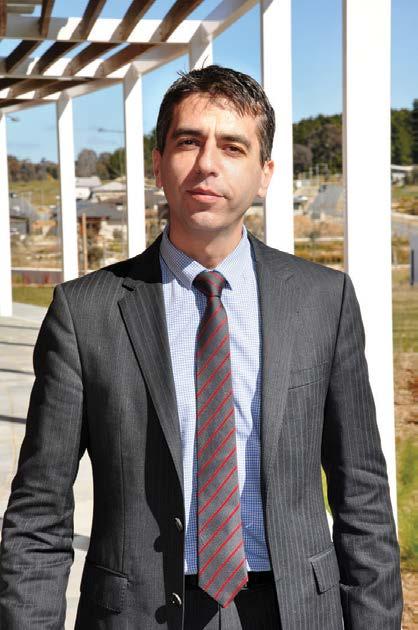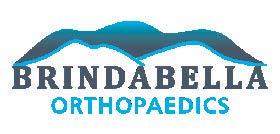Exit interview
6-8







Professor Paul Kelly reflects on his remarkable career, and his darkest days leading Australia’s response to the pandemic.



6-8







Professor Paul Kelly reflects on his remarkable career, and his darkest days leading Australia’s response to the pandemic.


Canberra Health Services’ efforts to improve the training experiences of its junior doctors appear to be working, with strong results for the ACT from the Medical Board of Australia’s annual Medical Training Survey (MTS).
A record 528 junior doctors from the ACT responded to the independent survey in 2024 (compared with 455 in 2023) and 78% of these said they would recommend their current workplace as a place to train. This was a higher satisfaction rating compared with last year (73%) and just two percentage points from the national average (80%). It is in stark contrast to the survey results from 2021 and 2022, when only 60% of ACT trainees would recommend their training place.
AMA ACT President Dr Kerrie Aust said the results were a great news story for the ACT and CHS. “This is really positive and shows that the ACT Government and CHS have been listening to the feedback from junior doctors,” Dr Aust said.
“This is so important because attracting and retaining doctors is such a big issue for our region, and we need to do all we can to make sure our junior doctors have the kind of training experience that makes them want to stay, or if they go away for further training, to return to Canberra.”
This is the sixth edition of the MTS, which has become the largest medical training survey in Australia, completed by more than half of Australia’s doctors in training nation-wide (nearly 25,000 trainees). The survey is seen as a valuable tool to evaluate the training landscape and shape strategies for improvement.
On average, ACT respondents to this year’s survey were in their fifth post-graduate year. 40%
were specialist non-GP trainees, 23% were prevocational trainees, 9% were interns and 6% were specialist GPs trainees. 61% of respondents were graduates of the ANU medical school, while 22% were International Medical Graduates (IMGs).
Among the most encouraging results from the survey:
89% of ACT interns felt their medical school education sufficiently prepared them for their intern year, compared with just 81% nationally
83% of ACT trainees rated the quality of their supervision as excellent or good, compared to 87% nationally
among almost 100 IMGs from the ACT who responded to the survey, 85% had a professional development/ training plan and 92% agreed there were opportunities for them to meet the requirements of their plan in their setting
97% of ACT trainees said
they were able to contact other senior medical staff in hours if they were concerned about a patient; and 92% said they could contact senior medical staff after hours CHS has made significant investments over the last two years to improve the work and training experiences of its junior doctors. This includes appointing a staff psychologist, as well as creating new roles

and programs to support unaccredited registrars and IMGs to progress through their training.
The survey identified continuing areas for improvement for the ACT, but these were broadly consistent with what was identified nationally. For instance, only 70% of ACT respondents rated the quality of their orientation as excellent or good. Furthermore, only
Continued page 3



In the past few weeks
I’ve had the enormous pleasure of joining together with medical colleagues at the 20th birthday celebrations of the ANU medical school, and then again at GP24 in Perth.
Looking around each room and seeing the faces of so many wonderful people, I’ve been struck by the generosity of so many brilliant doctors in our community, who give so much for their patients, and for the enrichment of their junior colleagues. I especially love seeing the junior doctors at these gatherings and reflecting that it was not long ago that I was in their shoes. Medicine can feel lonely, whether you’re a student or junior doctor trying to get through your exams, a consultant who knows the buck stops with you, or dare-I-say, the AMA ACT President trying to help government understand the irreplaceable role that doctors play. In moments like these, it’s such a powerful encouragement to remember all those faces at events like the ones I’ve been at recently. We really do have a community that shows up for one another. Drs4Drs ACT is another wonderful example of that – a telephone helpline, where doctors can pick up the phone any time day or night, any day of the year, and talk to a fellow doctor who will listen and not judge them. If you need help this Christmas season, the number is 1300 374 377 (1300 Dr4Drs). We are happy to help.
In the wake of October’s ACT election which delivered a minority Labor government for the ACT, AMA ACT sees some new advocacy opportunities in 2025. We were pleased to see support for investment in the health system by the Labor Government. We are committed to continuing to advocate for strategies that
lead to improved outcomes for patients and make the ACT an attractive place for doctors to work and live. The themes that were identified during our member engagement sessions include attracting and retaining our doctors, reducing the fragmentation and inefficiencies in our health system, maintaining clinical autonomy and improving the transparency and communication of our wait times and clinical outcomes. We will continue to advocate for improvements on the issues that underpin these themes. The financial viability of clinical practice remains a challenge – just this week I was speaking with Independent member, Thomas Emerson, about the impact of payroll tax on practices in the ACT and our need to attract GPs and non-GP specialists to work in the Territory.
Our eye will always be on how the hospital maintains both equity of access for patients to healthcare and the importance of clinical autonomy.
Dr Kerrie Aust
The Greens meanwhile, say they’ll be using their position on the crossbench to call for the creation of an independent board to oversee our health and hospital system. I’ll be meeting regularly with the different elected members in the new year to make sure they’re well briefed on the issues. In the last few weeks of the year Canberra Health Services announced a restructure, centring around a new Operations Centre to manage patient flow at Canberra Hospital. CEO Dave Peffer has spoken about how ‘a bad system
will beat a good person’ and hopes that the structural changes improve both the patient and clinician experience in the hospital. We have had feedback from our doctors about the potential for this to lead to better information about the patient journey, that could be used to drive system improvements. We look forward to our upcoming tour of the facility and the opportunity to provide feedback about the changes. Our eye will always be on how the hospital maintains both equity of access for patients to healthcare and the importance of clinical autonomy.
An end is in sight for salaried medical practitioners’ ongoing pay dispute with the ACT Government. At a Directions Hearing in November, the Fair Work Commission determined the matter will be heard on 3 March 2025 and run for 3 to 5 days. AMA ACT is currently preparing our evidence that we will present on behalf of members in this important case, and we may need your input and cooperation in support of this process. The outcome that we’re seeking is a set of fair and reasonable salary increases. We’ll provide further updates as this matter progresses.
AMA ACT puts on some wonderful events across the year, that are invaluable to building a network of support for doctors. 2025 kicks off with our annual medical student welcome drinks on Thursday 30 January at the Athenaeum Room at Llewellyn Hall at ANU from 7pm. All AMA members are welcome to attend. Details can be found on the AMA ACT website. In 2025 AMA ACT together with Drs4Drs ACT will also continue to run our Safe Space events. These are an opportunity for medical students and doctors to hear from speakers on topics relevant to building a sustainable career in medicine. Each Safe Space event also includes optional social leisure activities. In the past we’ve had axe-throwing, traditional drumming workshops and fun runs. Keep an eye on the AMA ACT website

for details of upcoming events.
Merry Christmas
On behalf of the AMA board and staff, I’d like to thank all our members for their support this year and wish you all a
wonderful festive season and a safe and happy new year. While I know not all of you will get the time off you would like, I do hope you will at least feel the warmth of the season and connect with those that you love.
The ACT Government’s highly controversial Variation in Sex Characteristics
(Restricted Medical Treatment) Act has hit implementation snags on the eve of new penalties coming into effect.
From 23 December doctors face fines of up to $32,000 and two years imprisonment for undertaking a restricted medical treatment without approval on a person deemed to have a Variation in Sex Characteristics who does not have decision making capacity regarding the treatment. The new laws are considered world-leading by some human rights advocates, especially the intersex lobby. They are designed to protect people from being harmed by inappropriate medical treatments and to support them to make their own decisions about non-urgent medical treatment. However, in the first week of
Continued from cover
67% said they had access to protected study time or leave and only 63% said they had access to a working space such as a desk and computer that was excellent or good. Only 67% of prevocational and unaccredited trainees in the ACT had a training/ professional development plan, although this was higher than the national rate (56%).
One in three ACT trainees reported that they had experienced or witnessed bullying, harassment, sexual harassment, discrimination
December, the ACT Government was moving to amend the legislation, after it became apparent that it was causing problems for some patients already receiving treatment.
“During the implementation period it became apparent that the legislation captures ongoing treatment for young people who are already receiving treatment for a variation in sex characteristics,” an ACT Government spokesperson said. At the time of going to print, the Government was seeking to pass legislation that would grandfather prescribed persons who had already commenced treatment onto the scheme for the first 12 months.
For these patients and their doctors and carers, the requirement to have an approved treatment plan and the penalties associated with this would not be in effect until December 2025. “This amendment will ensure continuity of care and provide time for the development and submission of Individual Treatment Plans,” the spokesperson said.
and/or racism in their workplace.
This was consistent with the national results, which also highlighted that reports of racism were double for Aboriginal and Torres Strait Islander doctors in training compared to the national average.
Medical Board of Australia Chair, Dr Anne Tonkin said she was “appalled by what Aboriginal and Torres Strait Islander trainees report”.
“Our efforts to strengthen cultural safety in medicine and the health system more widely are urgent and well targeted. Our health system and our community need to do better,” Dr Tonkin said.
There is disagreement between medical and non-medical experts over how to define a Variation in Sex Characteristics under the Act. For instance, in a recent webinar hosted by Capital Health Network, panellists disagreed over whether using a steroid cream to treat phimosis in a child without decision-making capacity before exploring the option of circumcision would warrant an application to the new Restricted Medical Treatment Assessment Board.
Dr Michael Rosier, a paediatrician on the Board, took the view that such a case “would not need to come before the committee” as circumcision is not one of the prescribed conditions and the treatment would not change the patient’s sex characteristics. However, two non-medical panellists argued that such a treatment would fall under the legislation, meaning it should only proceed on the basis of an approved treatment plan. Under the Act, doctors and other specified persons can make an
application to the Board on behalf of an individual, while certain people approved by the Health Minister can make a general application on behalf of a category of patients.
AMA ACT President Dr Kerrie Aust called on the Health Directorate to make clear on Health Pathways which conditions it deems Variations in Sex Characteristics, and where possible, to create General Treatment Plans for these conditions.
“The preparation of medical treatment plans needs to be appropriately resourced,” Dr Aust said. “Our clinicians in both public and private have no extra capacity in addition to the current patient load, and we have been advocating for this to be urgently addressed.”
A Canberra paediatrician who spoke with Canberra Doctor on the condition of anonymity said the new laws were causing “a significant amount of distress from parents as
they realise their children are going to be covered by the legislation”. “Clinicians all remain significantly upset by the criminal penalties that now apply in the ACT for what is standard practice around the world,” they said. This particular doctor said they would not be writing any individual treatment plans. “Parents will have to apply to the tribunal and then come back and tell us what they’ve been told we can do,” they said.
An ACT Government spokesperson told Canberra Doctor that no general treatment plans have so far been approved. Asked how many applications for individual treatment plans had been made and/or approved, the spokesperson said they could not provide such detail “due to the potential to breach patient privacy”.
Canberra Doctor has sought general legal advice in relation to the new legislation, however all the lawyers we contacted declined to comment.
On behalf of all the members, AMA ACT would like to thank everyone who took part in industrial action as part of our efforts to secure a better pay offer for salaried doctors in the ACT.
Your efforts have been effective, with the ACT
Government agreeing to an application from ASMOF, and supported by AMA ACT, for the Fair Work Commission to make an Intractable Bargaining Declaration.
The ACT Government, as employer, initially opposed the application but later changed its position – quite likely as a result of pressure applied by employee parties through the protected industrial action.
The Fair Work Commission is expected to make a binding determination on unresolved

matters in the first quarter of 2025; namely, pay outcomes for medical practitioners.
AMA ACT is extremely hopeful that the outcome will be a set of fair and reasonable salary increases that contribute positively to the conditions of employment offered to ACT public sector medical practitioners.

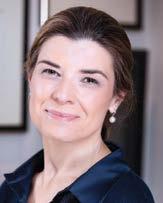
Over 25 years experience in Orthopaedic surgery, including 19 years in Canberra working in private and public practice.
Arthroscopy, Reconstruction, Replacement and Trauma of the Shoulder and Upper Limb. Includes arthroscopic and open shoulder stabilisation, shoulder replacement, rotator cuff repair, elbow, wrist and hand surgery.
Ph: 02 6260 5249 | katherinegordiev.com.au Suite 7 National Capital Private Hospital, Garran 2605
Freshly retired, Professor Paul Kelly speaks freely about what it was really like to lead Australia's response to the Covid-19 pandemic.
BY SARAH COLYER
Professor Paul Kelly is used to people tilting their heads when they pass him on the street these days, a flash of recognition in their eyes. “I can see them thinking, ‘Do I know you?’” he chuckles.
Between 2020 and 2022 Kelly’s face was one of the most recognisable in Australia. As the nation’s top doctor, he fronted the media daily to update Australians on the evolving Covid crisis. “I got quite agoraphobic for a while there,” he says. “I felt like I couldn’t go anywhere without being recognised.”
Mostly the attention was positive, like the time Kelly and Professor Brendan Murphy were walking along Macquarie Street in Sydney, and the driver of a ute threw half his body out the window, shouting “you’re doin’ a good job fellas!”.
Another time however, Kelly remembers feeling physically threatened, crossing paths with angry protesters on his way back from a swim at Civic pool. Happily, those times have passed, and Kelly feels comfortably anonymous today sitting at his local café in one of Canberra’s leafy suburbs. He’s looking relaxed in shorts and sandals, having retired as Chief Medical Officer in October. Lately however, he’s been re-living the memories of his frontline experience of Australia’s biggest peacetime disaster as part of an oral history project through the National Library.
“I wasn’t sure how much I would remember, but, once I started talking I felt like I was back in it. That’s the PTSD thing,” he says. “It’s been great though; really cathartic.”
Before Covid
Even before the pandemic,
Kelly had made remarkable contributions to medicine in Australia and internationally.
Born in Sydney and raised in Perth, Kelly studied medicine at the University of Western Australia and initially thought he’d become a rural GP, having loved his time as a medical student in the Kimberley and as a junior doctor in the Pilbara. After medical school he went to the UK for two-and-a-half years, studying anaesthetics and obstetrics as a senior health officer. He then studied a diploma of tropical medicine in London and went to Malawi in Africa for three months, where he was involved in a randomised controlled trial of ivermectin for river blindness.
“At one point I was a world expert in ivermectin, so it was kind of funny that it came up again during the pandemic,” he laughs. Kelly came back to Australia and did a year of paediatrics.
“All of that training was with a view to going back to Malawi.”
Together with wife Jenny, and their young son, the family moved to Malawi, where Kelly worked at a Catholic mission hospital for three-and-a-half years and Jenny taught nursing.
“During that time in Africa I did everything: surgery, paediatrics, obstetrics – lots of complications in obstetrics – and public health. That’s when I got interested in public health.”
Upon returning to Australia, Kelly completed a PhD on HIV and tuberculosis, based on his work in Africa. He then got further qualifications as a public health physician and the family moved to Darwin, where they stayed for eight years. At that time, Kelly also made regular trips to East Timor and Indonesia, working on tuberculosis and malaria research and on health system strengthening.
“I had a couple of Timorese PhD students,” Kelly says, and his face
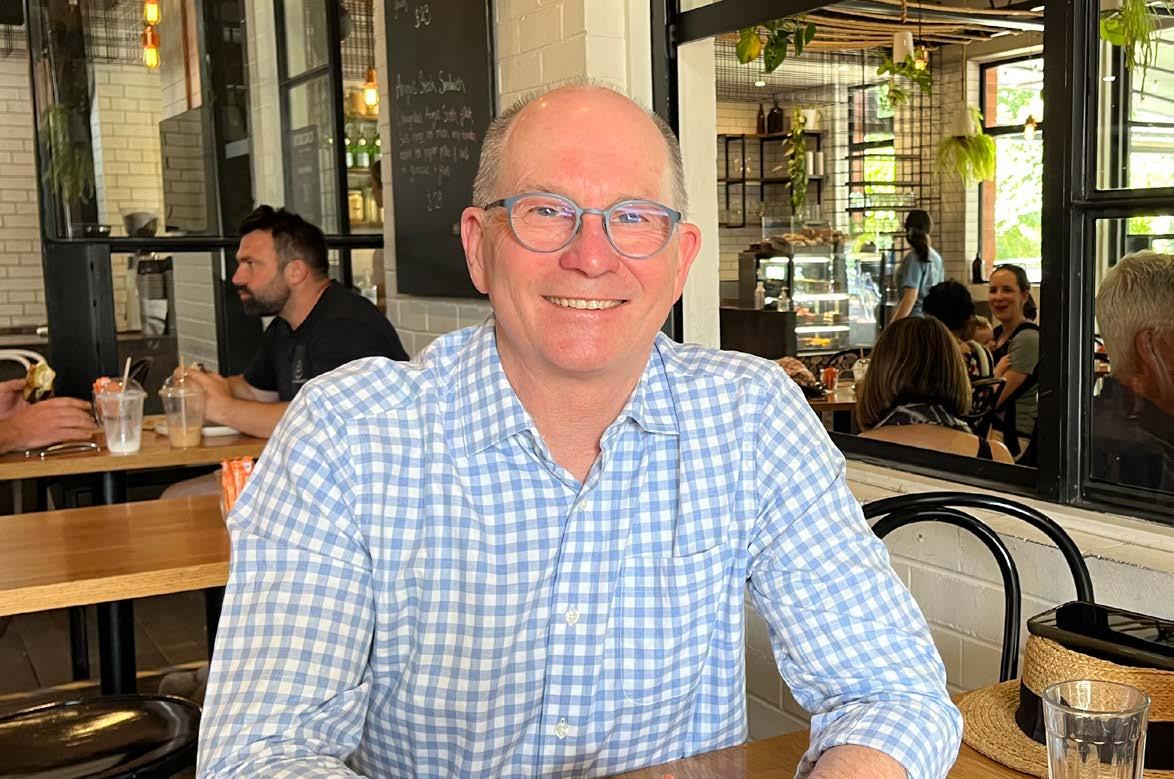
lights up. “One is now the dean of the medical school at the national university; another one was East
At one point I was a world expert in ivermectin, so it was kind of funny that it came up again during the pandemic.
Professor Paul Kelly
Timor’s second Heath Minister, so I feel like I’ve helped a bit.”
The Kelly family moved to the ACT and Kelly was the Territory’s Chief
Health Officer for eight years. He then went on to work as a Chief Medical Advisor within the Therapeutic Goods Administration.
Toward the end of 2019, Kelly deputised for Professor Brendan Murphy as Chief Medical Officer. The big issue of the day was the catastrophic bushfires sweeping across the eastern states, but there were also growing concerns about an emerging coronavirus strain overseas.
pandemic
When Professor Brendan Murphy became Health Department Secretary in June 2020, Kelly stepped up as acting CMO (appointed on a permanent basis that December).
Kelly’s days would begin at 5.30am, when he would listen to the BBC news to find out what had happened in Europe and
North America overnight. Then he’d listen to ABC Radio National, when Dr Norman Swan would often talk with Fran Kelly in the early morning, setting the news agenda for the rest of the day. He’d often be on morning radio shortly after that. Once the radio was done, there would usually be a press conference and TV interviews. Kelly says he is glad to have had a wonderful media team that helped brief and prepare him.
Kelly is a great storyteller, weaving in funny little anecdotes and tangentially related stories, but always returning to the main point. Although nothing could prepare him for the media storm that came with being CMO during the pandemic, he says he had done “a bit of media” in the past, and not only as the ACT’s CHO.
“My dad passed away earlier this year and I was cleaning out the house in the last few months, and
I came across a clipping which I didn’t realise he still had a copy of. It was my first media interview from when I was 11,” his eyes twinkle.
“I was in a near-miss plane crash when flying back from Sydney to Perth on the red eye. It was wet and dark, and an international flight had been allowed to taxi across the tarmac just as our plane was cleared for take-off.
“Our plane hit the tail of the other one, and knocked it off. It ripped three-quarters out of the bottom of our plane and just missed the fuel lines. The pilot was very calm. We all exited by the slides. The funny thing

is, I can recall everything about that day, except for going down the slide.
“Anyway, I told the reporters who met us in Perth that I wasn’t scared. So that was my first media appearance.”
Speaking frankly, Kelly says addressing the media every day was so important during the pandemic, because “we were asking people to do a lot”.
“It was amazing how well Australians responded to so many impositions on their personal liberty, but it worked far better than we thought it would. Between February and April 2020 we eradicated Covid in Australia. It was amazing.”
Once the daily media interviews were done, Kelly’s attention turned to briefing the politicians.
“We were spending up to 20 hours a week briefing federal cabinet and then national cabinet as well,” he says.
There was also the daily Australian Health Protection Principal Committee (AHPPC) meeting, involving the CHOs from each state and territory, which went for 2 hours or longer, sometimes twice a day.
“On top of all this, we were also running the response in the Health Department, and for most of the government actually,” he says.
“Myself or one of our deputies were on multiple committees across government trying to make sure we were working in the same way.”
many of the things he finds good for his physical and mental health fell by the wayside during Covid, including his beloved Scottish dancing and ritual morning lap-swims.
“My wife Jenny was a tower of strength to me at that time,” he says. “Jenny took on 100 percent of the domestic duties, which was amazing and kept me going. We’d try to have dinner together at 7.30 or 8, and then I’d go back to work until 10 or 11, or longer.”
Kelly’s wider family also supported him, including his dad, who was a great mentor, having worked in executive management himself.
One of Kelly’s uncles meanwhile, a retired surgeon, would send him a daily limerick summarising each day’s events, with quotes from Kelly and the various ministers.
“They were very funny, sometimes a little risqué, and I would share them with then Health Minister Greg Hunt and the Prime Minister occasionally,” Kelly says.
Of all the days of the pandemic, there’s one that has weighed on Kelly’s mind the most. It was 30 September 2022, when he gave a press conference with Prime Minister Anthony Albanese and all the state and territory first ministers telling Australians a decision had been made to remove
Kelly had no doubt it was the right decision. “By then almost everyone had had three doses of vaccine and most people had had Covid. It was disproportionate that we were still locking people up for two weeks when they were positive. The pandemic response was starting to show economic effects. Up until then we’d been so successful in not disrupting society at that macroeconomic level but now there were hundreds of thousands of people on furlough and their kids were not going to school; and supply chains were starting to be disrupted and the health system was under strain due to staff absenteeism. Opening up just had to happen.”
However, the decision to bring an end to ‘Covid exceptionalism’, as Kelly called it, was taken without consulting the CHOs. Indeed, only a handful of Kelly’s closest colleagues knew the announcement was coming.
“I was instructed not to talk to the state and territory CHOs, but to give my advice directly to the PM. Although that had happened a couple of times during the previous government as well, this was the biggest decision since we closed the borders.
“All the way through the pandemic, the health advice was leading the politics, but at this stage, it was a done-deal politically

Kelly says he showed his advice to two or three colleagues to check, including Murphy, but that was all.
“I rode that one myself,” Kelly says.
“I didn’t want to lay blame for this one on anyone else. It had to be me.
I was the only one who understood the nuance of the issues from a technical point of view, but also the political point of view and the relationship-with-the states point of view, and I just thought it was the right thing to do. Ultimately it was my advice and I put pen to paper.”
Opportunity 1: Buy the practice
Medium sized clinic, established in 1997
Retiring Principal GP
• Located in a convenient South Canberra suburb close to ammenities and hospital with easy access for emergency services.
• 2 consulting rooms, 1 proceedural treatment room, 1 crash emergency area.
• Medium size space adaptable for storage if needed.
• Fully computerized, including Best Practice Software.
• Fully equipped including Tuttnauer Autoclave, Vaccine Fridge, Schiller Cardiovit AT-2. Plus 2 Defibrillators, 2 Electric Examination Couches, Welch Allyn Spirometer, AeroNebFortress Nebulizer, 2 Roller Stand Sphygmomanometers, 3 cuff -mounted Sphygmomanometers, 1 Instrument table, 2 one drawer stainless steel trolleys, 2 Photocopiers (1 black & white, 1 coloured).
• Worthwhile goodwill
• The "practice space" is currently on an annual rental lease basis.
• The lessor will be keen for a long-term rental tenure lease, if preferred.
• Mixed billing
• Free parking space

Walking out of that press conference, Kelly says he knew several colleagues would feel betrayed. He went back to his office feeling “really low”, by his own account. He phoned Queensland Governor, Scan for more information or contact us on Mobile: 0411 162 965 Email: onward21@tpg.com.au
Opportunity 2: VR GP
Partnership opportunities, with view of buying
Suitable for Canberra GP with established patient base wishing to relocate to a different suburb in Canberra.
• Located in a convenient South Canberra suburb close to ammenities and hospital with easy access for emergency services.
• Worthwhile goodwill
• 2 consulting rooms, 1 proceedural treatment room, 1 crash emergency area.
• Fully computerized, including Best Practice Software.
• Fully equipped
• Mixed billing
• Negotiable rates. $150/hr guaranteed for the first 3 months.
• Work hours to be negotiated.


Continued from page 5
Dr Jeanette Young, who had previously been the state’s longstanding CHO. “She told me ‘You had no choice. You had to do it.’”
The rest is history. “The sky did not fall in,” Kelly says.
A few weeks later, Kelly’s team got all the CHOs together for a black-tie dinner with Dr Young at Government House Queensland. “It bonded us back together again. That was really important because there were lots of other decisions to be made and we had to remain an effective team,” he says.
Now in retirement, Kelly says this is one of the first times he’s spoken freely about his experiences during the pandemic. While he frequently mentions the importance of freedom of speech, and the value of democracy, he was clearly frustrated by some of the media commentary during and after the pandemic, including in the wake of the Covid-19 Response Inquiry Report’s release in October.
“It really gets in my craw, the criticism that my team and I were in some

It really gets in my craw, the criticism that my team and I were in some sort of closet.”
Professor Paul Kelly
sort of closet, taking a very narrow view of the virus. That was never the case. When I look at my colleagues in each of the states, that was never the case with them either. It was never just about the disease. They’re all public health trained; they take a wide view of human health and wellness, and that includes the societal and economic effects.
“Thinking back to those early days of the pandemic, our job was to save lives. Others were involved with working through the economics of that. But I, amongst others, pushed the government to make sure that they were thinking of the concept of reciprocity, so even while we were asking people to stay home from work, those JobKeeper and JobSeeker economic supports came through.”
While Kelly fiercely defends his colleagues in public health, he says there were other doctors who became hugely popular in the media during the pandemic who were “frankly unqualified to speak common sense”.
“These people in the ‘elimination camp’ kept looking for the silver bullet – whether it was masks, or lockdowns, or vaccines, or antivirals or indoor air quality. But it was unrealistic. We were never going

Drs4Drs ACT is available any time day or night to support doctors in distress.
Medical Director, Dr Marisa Magiros, answers some frequently asked questions about what happens when you call the hotline.
Who will pick up the phone when I call?
When you call 1300 374 377 you will be connected to the doctor on call via a triaging team.
to keep the virus out forever. “They were loved by the media and they fuelled what happened in the states. That sometimes led to disproportionate responses; bad decision-making.”
“They were smart people –infectious diseases physicians, virologists, researchers – who were able to explain a lot of the biology and virology; but the real experts were able to explain the biology and virology as well as the effects on health services and the economy and society, and they were the chief health officers.”
Compounding these tensions were the challenges of working within a giant bureaucracy. “The reality is that government apparatus is set up to be slow – some would say ponderous, others would say cautious,” Kelly says.
“Having to respond to changing situations within days or even hours really stretched people. There was a reluctance to move out of the usual way of doing things.”
Kelly says unfortunately, he believes Australia is less well prepared for the next pandemic than it was for the last one.
“If there were a pandemic tomorrow, I think there would be more resistance and questioning of public health responses,” he says. Nevertheless, Kelly is philosophical. “We live in a democracy. There’s a lot of negotiations – it’s a dance. I thought of dancing quite a lot during the pandemic. Sometimes you keep people in tight, and sometimes you have to let them go. Sometimes things have to develop before you can respond.”
Since the pandemic has ended, Kelly has added a swag of further remarkable achievements to his name, including leading the establishment of the interim Centre

for Disease Control, launching Australia’s first health and climate policy, seeing the respiratory syncytial virus (RSV) vaccine added to the National Immunisation Program and establishing the National Occupational Respiratory Disease Registry. So, what’s next?
“I need to switch off,” Kelly says.
First stop is a yoga retreat with Jenny in India. Then he’s off to Ireland to
I took a long and deeper look –our friend on stage an open book, with honest face and hands that shook while clutching hard his speech. Saluting, we, his first career, concluding with a smile, a tear; it was an honour to be here and hear the speakers reach for metaphor and simile that hundreds of us did agree delivered truth delightfully, of how we owe this man.
The Minister and Murph and Blair and worthy people spoke their share of gratitude for Paul’s deep care –the decades did it span.
receive an honorary fellowship from the Royal College of Physicians of Ireland. “Anthony Fauci was the last person who got one so I feel like I’m in good company,” he says. One wonders whether the eminent Dr Fauci enjoys the same anonymity in his home city as his brilliant Australian counterpart, whom most Australians only vaguely remember.
Cause it’s not easy on the beach to order waves, “Desist! Don’t breach our borders till we teach our people, WEAR A MASK”. And it’s a special kind of soul to educate, berate, cajole; true leadership, it takes a toll –we gave him quite the task.
So vale mate, that’s if you go, but honestly – we know, we know –you’ll be back soon, say it’s so, more tasks the world will send. Fight cant, injustice, poverty, in some new gig specifically designed for our own Paul Kelly –Professor, leader, friend.
Can I really call any time of night?
Yes, the support line is covered 24/7.
What happens if the person on the other end is someone I know?
If you would prefer to speak to someone else you can choose to leave your number so that a different doctor from the team can call you back. The ACT team currently has 6 experienced volunteer doctors sharing the on-call roster, each covering a week at a time.
Will I need to provide my name?
No. You will be asked your name to
personalise the conversation but you can choose to remain anonymous.
What kinds of things can I call about?
Anything and everything! The range of calls received include asking for recommendations for a GP, psychologist or other medical specialty for acute illness, stress or burnout; discussing concerns about exams, relationships, work conditions, moving locations, health of loved ones, financial crisis; experiencing personal or professional conflict; dealing with a patient complaint or notification to Ahpra or another legal or regulatory matter; experiencing grief or bereavement; seeking career advice and more.
Can I call on behalf of a friend or family member who is a doctor?
Yes, if you are concerned about a doctor you know and care about, who is struggling with their health or wellbeing, please don’t hesitate to contact us. We can offer resources and advice about how to support the doctor and may be able to recommend a GP who treats medical colleagues if required.
What are the typical next steps after I make a call to Drs4Drs?
The on-call doctor will listen to your concerns, provide guidance, counselling and
resources to meet your individual situation. Some common outcomes include recommendations or referrals to a GP, psychologist or other specialist; suggestion of a mentor or peer support; provision of details for resources including Medical Benevolent Society; or referral to support services within universities, hospitals, colleges or medical defence organisations. In some situations follow-up may be arranged.
To find out more go to: drs4drs.com.au/resources
Resources include FAQ, information, 5 minute guides, reading and podcasts.
Canberra GP Dr Andrew Palfreman, owner of Watson General Practice, and the team at Next Practice in Deakin have both been recognised as Medicare Champions at an awards ceremony organised by the Australian Government to celebrate Medicare’s 40th birthday.
Dr Palfreman and Next Practice were selected out of more than 140 exceptional nominations from around Australia to be
among the 20 individuals and teams named Medicare Champions at a ceremony at Parliament House in November.
Dr Palfreman was recognised for his extraordinary efforts to provide high quality general practice care during Covid. His team quickly pivoted to 100% telehealth when the lockdowns began, and then set up a demountable clinic in the carpark so patients who needed face-to-face care could still be seen. Dr Palfeman and his team also established an outdoor vaccination clinic, where they vaccinated 400 people each day. In addition to his work through
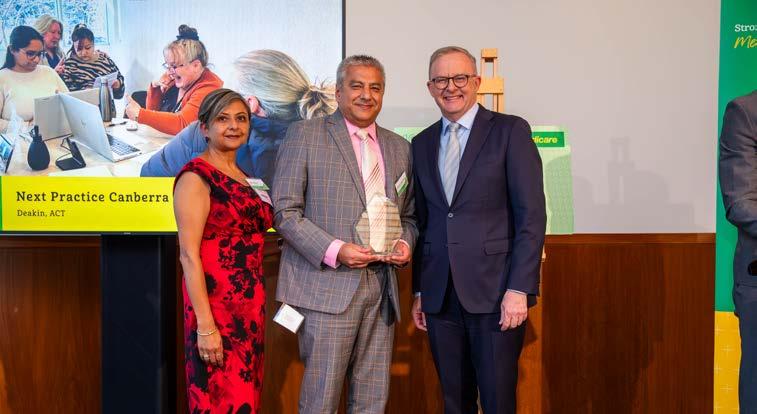
Watson General Practice, Dr Palfreman works at Directions Health and is a member of Canberra’s Deep End group for GPs caring for complex patients with mental illness.
Dr Palfreman said it was a “giant surprise” to receive the award, having been nominated by some of his colleagues at the practice. “To be honest, I feel a bit uncomfortable being recognised with this award, when I am a tiny cog in a gargantuan health system. There are so many GPs out there doing a lot of heavy lifting with complex care on the smell of an oily rag.”
Dr Palfreman said it was good to see the strengths of general practice getting some worthy attention through the awards.
“General Practice is out there quietly delivering patient care at a bargain price for government. The strength of general practice is in its comprehensive, whole person, longitudinal care,” he said.
“Working like a hub of a wheel with spokes, we have for years relied on multidisciplinary teams and I truly value working with excellent

nursing, pharmacy, psychology and allied health colleagues and long may this continue."
Dr Palfreman said he would love for Medicare to be going strong in another 40 years’ time.
“To get more out of primary care we need less devolution and fragmentation. We need more generalist doctors who can safely and empathically treat the whole person, not just parts,” he said.
The team at Next Practice Deakin in Canberra received their

award for their innovative model of multidisciplinary teams that form integrated practice units providing individualised care.
The Next Practice team includes GPs, nurses, nurse practitioners, patient advocates, social workers, diabetes educators, an oral hygienist, a practice pharmacist, a dietitian, an exercise physiologist, a geriatrician and a physiotherapist, along with three interstate nurse practitioners who provide virtual care.

ANU medical school alumni, staff and students from across the generations celebrated the school’s 20th anniversary in November at an event that highlighted the crucial need to keep investing in medical research.
The occasion was headlined with an inspiring public lecture from Australian of the Year and leading cancer researcher, Professor Richard Scolyer, who spoke fondly of his many close friends in the ACT, including much loved former ANU lecturer, Professor Jane Dahlstrom, in who’s honour the inaugural lecture was named.
“Jane showed me how to do research when I was a baby researcher and she’d done some really high-powered stuff,” Professor Scolyer said of Professor Dahlstrom, who was a few years ahead of him when they were both pathology registrars at the Canberra Hospital, working under Associate Professor Sanjiv Jain.
Professor Scolyer also spoke of his deep gratitude to Professor Jain, saying, “Sanjiv changed our lives in many respects.”
In November, Professor Dahlstrom and Profesor Scolyer were corecipients of the highest award in international pathology, the David F. Hardwick Gold Medal Award from the International Academy of Pathology, for their outstanding
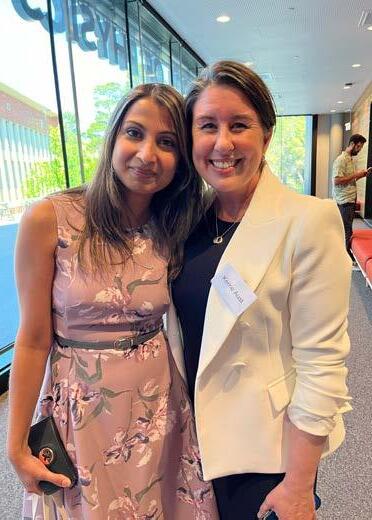
contribution to international pathology education and research.
Professor Scolyer spoke passionately about the need for persistence in research, sharing insights from his experience as director of the Melanoma Institute Australia, which boasts the world’s largest melanoma research and treatment facility.
“There’s so many questions that we should be addressing, that we don’t know the answer to, and we’ve just got to keep digging and digging to get us to zero deaths from all cancers,” he said, adding: “Translating discoveries from one cancer to another is really important.”
Professor Scolyer noted that up until 12 years ago most people would die within a year of being diagnosed with advanced stage melanoma. “Now, five-year survival rate is about 57% and we think most of those patients have been cured,” he said.
Nevertheless, one Australian still dies every six hours from melanoma, he said. “So we still have a lot of work to do.”
Professor Scolyer touched on his own cancer journey, having been diagnosed with Grade 4 glioblastoma in June 2023, and given just 12 months prognosis with the standard surgery-radiotherapy-

chemotherapy treatment.
His colleague and fellow Australian of the Year, Professor Georgina Long, suggested adapting melanoma immunotherapy to treat his brain cancer – a world first that would require him to forgo chemotherapy treatment.
“Without chemotherapy, average survival time drops in half, so it was obviously risky,” he said.
Professor Scolyer praised his wife and children and his team, who supported him to undertake
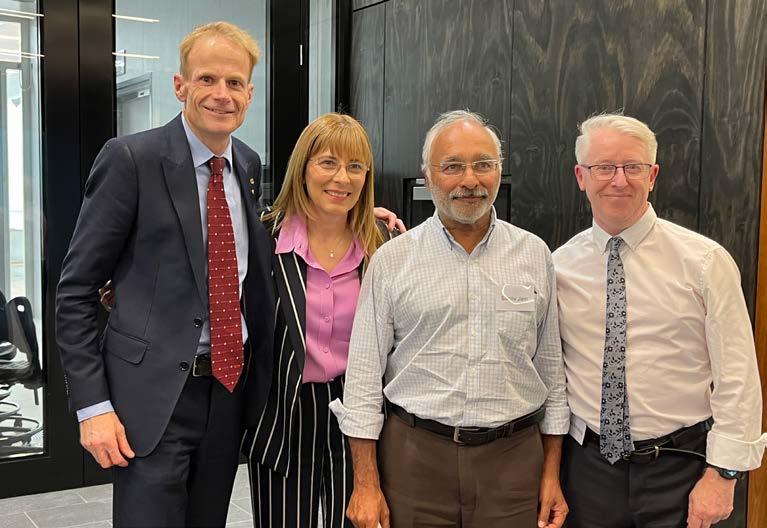
the experimental treatment, and shared that he was just one-week shy of surviving 18-months post-diagnosis.
“Roger Stupp said if Scolyer’s still alive in 18 months it’s a big deal,” Professor Scolyer said, paraphrasing the renowned oncologist after whom the standard glioblastoma treatment, the Stupps protocol, is named.
Professor Paul Gatenby, Foundation Dean of the ANU
Medical School spoke of the challenges that the ANU faces into the future.
“The most obvious difference between medical schools and most other university-based teaching programs is that most people who teach aren’t on the university payroll,” he said. “A large part of the teaching occurs in designated large and small teaching hospitals, or in the community, in general practice.
The financial underpinning of this is incredibly complex

There were many times in medical school when I was not ok and it was my lecturers and tutors who got me through.
and not always adequate; that’s an understatement."
Professor Gatenby said while he believed the ANU medical school was doing a good job at training doctors, in his opinion it hadn’t done nearly as well in research – notwithstanding a few “hotbeds of research” such as trauma and orthopaedics, the new clinical trial support unit, haematology and diabetes.
“I think the degree of interaction between the university and the health service is less than it ought to be and I think this is one of the
reasons why, while we’ve done well with research, we should and could do much better,” he said.
Current medical school Director
Professor Paul Fitzgerald praised the exceptional and dedicated ANU medical school staff and its many outstanding honorary clinicians –“many of whom, if not the majority, are alumni of the program”.
“I frequently hear of the enthusiasm of our alumni who have a really substantial commitment to giving back to the program and supporting our current students. This is invaluable and highly appreciated,” he said.
Professor Fitzgerald acknowledged the medical school was facing yet “another series of substantial changes” and would move into the College of Science and Medicine from January.
“Our staff have done an extraordinary job at maintaining education standards within the program despite the frequency of the changes that they have had to deal with,” he said. “However, it would be remiss of me to not acknowledge how difficult this has been for many and will

continue to be for some time.”
“Despite the challenges of the current time, especially within ANU, I think the program has a bright future and one that we can all help create,” he said.
The theme for the anniversary celebrations was ‘How to make a difference’. AMA ACT President Dr Kerrie Aust was among a panel of speakers to talk on this theme, alongside fellow alumni, Dr Jess King and Clinical Associate Professor Martin Dobes.

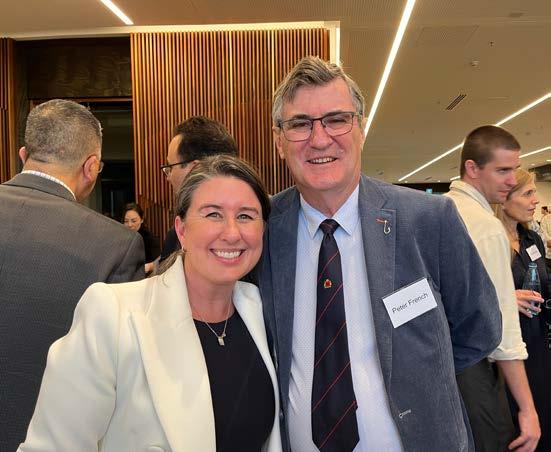
Dr Aust spoke about how the kindness of lecturers and tutors during her medical school days inspired her to advocate for doctors.
“There were many times in medical school when I was not ok and it was my lecturers and tutors who got me through,” she said.
being an Indigenous doctor working within Aboriginal communities in the Northern Territory. She spoke of the benefit of being able to communicate in local language and the sense of safety that patients have knowing that she understands the significance of culture.
Informing the Canberra medical community since 1988
As time went on, and Dr Aust saw many colleagues burning out, she was convinced that “doctors really needed a voice,” she said. This led her to volunteering with both Drs4Drs ACT and the AMA Board.
Dr King spoke of her experiences
Associate Professor Dobes spoke about what an honour it was to be welcomed back to his alma mater as an academic. Professor Dahlstrom praised him for his wonderful work to develop the school’s radiology program.
Since 1896, doctors’ wellbeing has been the core of MBA NSW-ACT’s mission. Our long history means we understand the unique and varied challenges that medical practitioners face. Our experienced specialised social workers can guide you through life’s challenges, whether the adversity is personal or professional.
For assessment, counselling, information, and advocacy
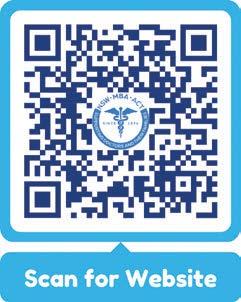

Financial Assistance
MBA can provide limited funds during times of financial hardship.
Our support is strictly confidential, free, and independent of the regulators. Please call 02 9987 0504 (Option 1) if you are facing an issue that is causing distress or if you want to explore options for a colleague. We are available Monday – Friday between 9am and 5pm and can schedule after hours appointments. You can elect to remain anonymous.
Help Us Help Others: If you don’t need our help now, please consider supporting our charity to continue this vital work, by making a tax-deductible donation.
• Contract checking service
• Unfair dismissals and workplace investigations
• Practice management support ama.com.au/join

Supporting you to ensure your rights are protected, no matter what career stage you are in. Email industrial@ama-act.com.au Phone (02) 6270 5418 • Public hospital matters • Negotiations and determinations • Performance management • Bullying and harassment

As my cohort weighs whether to accept a Canberra Health Services (CHS) internship or consider offers further afield, I reflect on my own journey through medical school at the ANU School of Medicine and Psychology (SMP). In doing so, I consider whether a return of service pathway may aid recruitment and retention of medical interns into CHS.
I admit upfront that my experience through medical school has been different to most. I am fortunate to have been sponsored by the Australian Defence Force (ADF) throughout my studies, and served in the Royal Australian Navy prior to medical school. This
sponsorship is in exchange for further service through a Return of Service Obligation (ROSO).
To be candid, I probably would not have been able to pursue medicine without this agreement. While acknowledging this, many of my friends and colleagues have attended medical school at a time when Australia’s cost of living has rapidly increased in the wake of the COVID-19 pandemic. While this may attenuate in future, there remains an enduring financial burden for medical students attending a full-time four-year course with a decreased capacity to engage in remunerated work, especially towards the later years of their education.
For many, studying medicine follows several years of undergraduate or post-graduation education. This is at least a cumulative seven years outside of a fulltime workforce; limiting remuneration prior to internship while accruing an indexed HECS debt. My cohort has almost certainly absorbed increasing daily living costs and annual HECS indexation while studying medicine.
I suspect that many of my colleagues have significantly reduced their part-time hours or ceased part-time work altogether during the latter years of medical school to focus on developing their clinical acumen. Preferencing remunerated work above clinical placements risks burnout, and
creates opportunity costs when schedules conflict between work and clinical placement. This likely becomes more acute the further one progresses through medical school, and is perhaps most impactful immediately prior to a new cohort of medical interns joining their respective health networks.
For my own experience, Defence funding has enabled me to transition from my previous career into medicine throughout the past four years. I have been privileged to engage with placement opportunities as a full-time commitment, and I am confident that this will make me a better future doctor (pending exams of course!).
ADF sponsorship is a niche path for medical students, but I submit that the return of service model used to support trainees through their medical school years is worth consideration. In my case, when I finish medical school, I will spend three years in hiatus from Defence in pursuit of a GP fellowship, and then return a minimum of five years of service to Defence (the degree length plus one year).
Such sponsorship is perhaps worth considering by CHS for its medical interns and RMOs. Namely, CHS could remunerate third and fourth-year students in exchange for a return of service during postgraduate years one and two. Such sponsorship would align with the Australian Medical
Council’s National Framework for these postgraduate years, and preserve the option for medical interns and RMOs to pursue community-based training in postgraduate year three if desired.
A pay grade for this sponsorship could be convincingly based upon the previous industrial agreement for the ‘Medical Student Covid Worker’ or indexed against a percentage of the medical intern salary with the potential for increasing increments across the third and fourth years of medical school. Broader consideration could also be given to whether CHS could fund a student’s HECS debt in exchange for a return of service obligation.

A decision to remunerate third and fourth-year students could replicate the opportunity that I have been afforded by Defence and likewise empower students to approach medical school as a full-time commitment. Any medical school would welcome increased attendance among its students, and remunerated learning may benefit the curriculum as well as participating students. In doing so, medical students could dedicate more time towards clinical placements or studying towards medical internship. Alternatively, a return of service arrangement may also guarantee a portion of the medical intern and RMO workforce for the CHS in
matters and would be worth consideration between the SMP and CHS if sponsorship was further considered. However, at its core a sponsorship pathway for third and fourth year students may well provide benefits to the SMP, CHS and students that outweighs this logistical complexity.
The author is a serving member of the Royal Australian Navy. He receives remuneration from the Navy and university funding through the Navy’s Graduate Medical Program. The opinions expressed herein are those solely of the author and do not necessarily reflect those of the Australian Defence Force, the ANU School of Medicine and Psychology or the ANU Medical Students’ Society.



1st year medical student, ANU
Reproductive health is a pillar of autonomy and gender equality, yet contraception methods available do not reflect this.
There are eleven mainstream female contraceptive options, providing flexibility and freedom of choice. For men however, there are just two: condoms and vasectomies. Options for male contraceptives are still in development, with a research focus on both pharmaceutical and implantation approaches. However, these methods are still several years away from being deemed commercially viable, begging the question: should we intensify our investment to expedite the development of this product, or consider abandoning the effort altogether?
The disparity of contraception options reflects historical gender roles and places a significant burden on women. As Arianne Shahvisi writes, asymmetry of responsibility creates asymmetry of blame. Societally, contraception is a woman’s role. Therefore, if contraception ‘fails’, it is her fault and often consequently her ‘problem’ to deal with.
During heteronormative intercourse, there are different risk levels that are consented to regarding pregnancy. This is simply a “natural inequality” that nothing medicine can do can solve. Nevertheless, the introduction of accessible, effective, safe and reversible male contraception would
be a step towards parity in this field. Not only would this be a progressive move for men’s reproductive rights and control, but this would also trigger conversations on a wider scale as to why this responsibility has historically fallen on women and whether it should remain so.
Female contraception options are known for their litany of side effects. These are generally considered worth the alternative – unintended pregnancy. Among the possible hundreds, sideeffects of female birth control include: bleeding, nausea, breast tenderness, weight gain, acne, decreased libido, mood swings, increased blood pressure, cystitis, depression, and an elevated risk of thrombosis and breast cancer. Despite wanting to both prevent pregnancies and be sexually active, many women are forced to change or even stop their birth control completely due to these effects. This fact is supported by research that found that only 32.5% of women found that their current method of contraception suited them “perfectly”. Whether these side effects are worth the outcome is a question that women face daily. This is on top of the associated costs, effort, time spent, inconvenience of appointments, remembering to use or renew, pain and discomfort of check-ups and the energy spent researching or experimenting to find the most appropriate option. From a medical and pharmaceutical standpoint, female birth control methods are approved because the side effects are considered less significant than the alternative. Pregnancy symptoms, maternal mortality and the risk of suffering from thrombosis, are some of the data points that are used for comparison – in which case, almost no matter the side effects, birth control is still preferable. Another reason these medications remain on the mainstream market is that the first female contraceptive pill, introduced in the 1960s, was approved
under less stringent regulatory standards. Since then, each new contraceptive has technically built on this foundation, showing improvements and thus gaining approval for widespread use.
The efficacy and side effect profile of male contraception today are remarkably superior to when the female pill was first introduced, but due to the current regulatory climate, cannot be released to the public. The option for male birth control would make a profound difference to those in relationships where the female counterpart struggles with taking birth control, still allowing for reproductive autonomy within the relationship. Additionally, it would offer the option of dual contraception when both partners use it. Any male contraceptive that hits the market, regardless of the lack or presence of side effects, would not just help ease the physiological burden of birth control for women but also the mental burden.
Men currently only have the option of condoms and vasectomies to control their reproductive activities. For sexually active men who do not wish to have children, vasectomies are an effective, reasonably priced and safe method of sterilisation, however for various reasons, including cost, many men are reluctant or unwilling to undergo the procedure.
The introduction of a male contraceptive that is financially and readily accessible would allow for improved equity within reproductive health for men. Additionally, studies show that there is the demand in the market; a recent Australian survey finding that 75.4% of men would consider trying a birth control method if it was available.
The concept of the male role in contraception (aside from condoms) is not a well investigated area, resulting in superficial doubts about men’s reliability when it comes to their consistency and

Only 32.5% of women said their current contraception method suited them "perfectly".
accuracy of taking birth control. Studies show that generally, women would trust their male partners to take birth control.
However, an investigation in France saw that after being educated on the prospective male birth controls that would be available for male contraception, only 46.7% of women surveyed found this option as acceptable.
Common notions as to why women ‘would prefer to use birth control themselves’ (considering monogamous relationships), were cited as women’s tendencies to be “more in contact with the healthcare system than men” and that “women value control”. While both can be true, weaponised incompetence underlies these suggestions, cementing the burden of contraception to fall entirely on women.
The trust placed in an individual you’re choosing to have sex with because they claim they are on birth control, presents an issue. This applies more frequently to casual scenarios, raising many flags – e.g. if two heterosexual people have sex and the woman lies about being on birth control, she may fall pregnant, which she has consented to. If a man lies about being on birth control, the woman is not consenting to the increased possibility of falling pregnant. This begs the question of how dissimilar this is to a man lying about condom use (e.g. stealthing) – which is currently considered illegal in Australia. Legislation surrounding sex by fraudulent inducement would need to be updated to become more specific.
An estimated 80-90 million unintended pregnancies occur annually, indicating that there clearly are gaps in the contraceptive market. The challenges that arise when discussing the development of male birth control are numerous and significant. Understandably, the doubts regarding male reliability and the lengths that would be required for many women to trust its effectiveness are considerable. Substantial mindset and legal adjustments would also be needed to ensure continued or enhanced safety in contraception and responsible, consensual sex. Despite these concerns, the benefits that the development of male contraception could provide for both men and women are significant enough to warrant investment and prioritisation. Moreover, the possibility of this development furthering gender equality is equally valuable as the potential to reduce harm to women, by providing alternative options to current pharmaceuticals with adverse effects. Finally, the prospect of providing men with the independence and autonomy that are not effectively addressed by current measures, holds significant value. Ultimately, embracing this change could redefine the landscape of reproductive rights and gender equality.
*This essay was written for the subject, Professionalism and Leadership, and has been edited for length.
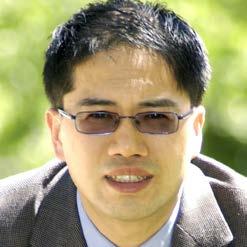

Associate Professor Jeff Looi is clinical academic neuropsychiatrist at the ANU School of Medicine and Psychology and president of ASMOF ACT. He’s also an avid reader. Here are his suggestions for books to pack in your suitcase these summer holidays.
An economist and professor from the London Business School tackles, in an informative and entertaining way, how to better interpret evidence presented to support arguments in public discussions. Of course, there is reference to the concept of randomised controlled trials, as well as considering how to better reason towards evidence-based conclusions.
The best minds
Jonathan Rosen
An elegiac narrative of the decades-long mental illness of author Jonathan Rosen's friend and a tragic legacy, across time
and memory. Haunting, harrowing and moving in equal parts, it depicts the hugely personal cost of severe mental illness that even the felicities of talent and fortune cannot always rescue.
For those who like well-written, but intriguing mystery, accompanied by action. This is the novel basis of the second season of the Jack Reacher video series on Amazon Prime, arguably enjoyable whether or not the series is viewed. It’s much like an earlier novel from Lee Child on which the first season of the Amazon series was based, The Killing Floor, and greatly distant from the Hollywood film versions.

Sleekly and sparely written by the poet and novelist James Sallis,

and fortunately also distant from the Hollywood film, these novellas are classical crime noir where every word, action and silence is meaningful.
BY
EMILY RYAN*
*Emily is a Junior Doctor Advisor with AMA ACT and a third-year medical student at the Australian National University, currently completing a rural placement in Bega. This medicine-themed crossword reflects topics she and her peers have been exploring in their studies this year. See answers on page 14.

After a year of discussion papers and countless workshops and meetings, the final report of the Scope of Practice Review was finally released in early November. The 194-page report contains 18 recommendations ranging from sensible, small reforms through to others I would politely refer to as ‘questionable’.
Titled “Unleashing the Potential of our Health Workforce”, one of our major frustrations with this review from the start has been its title, and the assumption that all regulation is bad — that “leashes” are just turf protection, rather than patient protection. Above all, there has been failure to answer the question of who should hold the leash. We firmly believe that decisions about scope of practice and workforce should be made by independent, expert bodies, with robust processes — not politicians with knee-jerk reactions. The AMA recognised the potential
threats to patient care posed by the review and was strongly engaged in the review through three public submissions and a confidential submission to the draft final report. We also provided a detailed literature review on the international evidence on nonmedical prescribing. This showed autonomous prescribing is not as prevalent or successful as other stakeholders would have you believe. We met with the lead reviewer, Professor Mark Cormack on many occasions, including inviting him to an AMA Federal Council meeting and when AMA ACT President Dr Kerrie Aust led him on a tour of her general practice. We also discussed the review regularly with the GP colleges and other groups to ensure alignment in our positions.
In discussions with the Federal Government and the Department of Health and Aged Care, we have explained the risks with many of these recommendations, such as fragmented care. Sometimes I feel like a broken record in these meetings explaining that we need to invest in and support general practice, not eternally fund programs that only circumvent general practice, inevitably cost more, and are less efficient. We will continue to press this message. I won’t detail all 18 recommendations, but I want to highlight a few that we are particularly concerned about and will continue to advocate against.
functions. We strongly oppose this on the principle that the regulation of health professionals exists to protect the community and ensure the highest standards of care for patients, and this is not something that politicians should be meddling in.
As we repeatedly highlighted in our submission, Australia has processes for reforms to scope of practice that are independent and consultative. The problem is these are regularly overridden by state and territory health ministers. This leads to the absurd situation where scope of practice is now determined by political promises during election campaigns rather than independent bodies with expertise in relevant skills and standards. The promises on pharmacy scope during the recent ACT election is one of many examples.
their full breadth of scope in primary care, but this requires better funding models and improvements to the many reforms currently underway in general practice, such as MyMedicare. We need strong clinical governance to ensure that full scope is safe scope, and that we are truly working together.

The 194-page report contains 18 recommendations.
support and use the mechanisms that exist — not reinvent the wheel.
Recommendation 6 is to introduce activity-based regulation of scope of practice to complement the status quo protection of title approach. This recommendation demonstrates the review’s continued failure to understand that scope of practice is dynamic and contextual — a qualification is not the sole determinant of scope. The determination of scope of practice should remain with the relevant National Boards. Proposals to expand scope should continue to proceed through the consultation process they currently undertake, with regulation impact statements conducted. We continue to be very supportive of enhancing collaborative multidisciplinary care and ensuring all health professionals can work to
The Australian Medical Council (AMC) recently released a comprehensive survey report capturing the experiences of more than 4,000 International Medical Graduates (IMGs).
The report shows how the journey to practice in Australia is often complicated by unclear information on pathways and slow processes, with little coordination between
Recommendation 3 is to amend the Health Practitioner National Law to grant health ministers the power to give Ahpra and National Boards even greater policy direction on registration and accreditation agencies. This then leads to delays in getting skilled doctors into jobs and providing medical care.
Among the report’s findings were that: 77% of participants on the Standard Pathway took more than a year to complete it. The main reasons for delays were passing the AMC clinical exam and getting a job so they could apply for limited registration.
62% of participants on the Specialist Pathway took more than a year to complete it. The
main reason cited for delay was assessment of comparability.
More than two thirds of respondents were interested in further training but 47% felt that the likelihood of being accepted into a training program was low.
Coming to Australia imposed sacrifices on family members, and this made the journey more difficult. Over half (52%) of respondents spent more than a year apart from family. IMGs also shared suggestions to
Recommendation 12 is to introduce direct referrals from non-medical health professionals to non-GP specialists. We never understood where the suggestions in this list came from (for example, osteopaths referring to orthopaedic surgeons), but the AMA was not consulted. As I highlighted directly to the reviewer, there have been many instances where an allied health professional has referred a patient to me with the expectation that I would then refer on to a non-GP specialist, only for the issue to be one I can easily manage as a GP. The issue is that our allied health colleagues do not understand the scope of a GP. This recommendation risks both the MBS budget and creating backlogs to non-GP specialists through unnecessary referrals. This recommendation is frustrating because our health system already has the Medical Services Advisory Committee (MSAC), which can consider the value of this recommendation. The same goes for recommendation 11 to introduce bundled payments for maternity care. MSAC is an independent, expert body that appraises proposals for public funding for new medical services and provides advice to government based on an assessment of its comparative safety, clinical effectiveness and cost-effectiveness. We need to
It's not entirely bad news — there are a couple of recommendations that we do like in the review, such as recommendation 7, the harmonisation of existing legislation and regulation, and recommendation 9, the establishment of an Independent Mechanism to provide evidencebased advice and recommendations on workforce models and scope of practice, provided it includes economic assessment.
It is important to note this is just a review. The government is yet to announce any actions in response to the report, and we are working to ensure any actions do not further fragment care or undermine our GPs. All our public submissions are available on the AMA website including our response to the final report.
improve their journeys, including streamlining and simplifying processes, lowering costs of assessment and registration, changing the moratorium, expanding resources and support, and increasing IMG representation in decision-making. Professor Cheryl Jones, AMC Director and Chair of the AMC Assessment Committee commented: “International medical graduates are a vital part of our medical workforce and make significant contributions to communities, especially in regional and remote areas.
“We acknowledge the complexity and challenges within the system. As the authority assessing international medical graduates, we are committed to ensuring that we have good systems and processes in place to improve the experience for international medical graduates navigating AMC assessment, while maintaining the highest possible standards to protect the health of the Australian community.”
To read the full report visit amc.org.au
BY RUSSELLE TRINIDAD AND SHEILA BRITO
A new trial is aiming to address some of the barriers that people with complex social and health needs experience when accessing health services, by putting social workers in general practice.
Preliminary results
Run through Capital Health Network (CHN), the Social Workers in General Practice trial enables social workers to work at their full scope of practice through co-location and integration into the multidisciplinary team.
The first 18 months of the trial have demonstrated positive preliminary results, including:
improved patient support, including counselling
better navigation of health care systems such as the NDIS and My Aged Care
education of staff and patients on scope of social work referral processes

better spread of workload across teams
support for patients while awaiting healthcare
better continuity of care
At the launch of the trial in 2022, social worker Paul Hill commented: “Why wait until someone gets very unwell and needs to go to hospital to place in social and community supports?
Why put the ambulance only at the bottom of the cliff? Social workers have unique skill sets to enhance our community’s quality of life and prevent hospitalisation through early intervention.”
Through this trial, the scope of practice for social workers embedded in general practice includes support with sociolegal issues (e.g. Advance Care Directives), grief, domestic violence, advocacy and assistance navigating government services.
Nadine Knight, a social worker at Wakefield Gardens Surgery highlighted the crucial role that she plays in improving communication between patients and their health care providers.
“I value the flexibility to conduct appointments not only here in the practice, but also at a patient’s

home," she said. "When patients are comfortable, they often more openly share their opinions and concerns. I can also learn more from observing their daily living, which I can relay back to the GP to enhance overall communication.”
Over the last 21 years as a social worker, Barbara Shone has worked with children and families. Barbara joined Next Practice Deakin in late 2022 as part of the trial. Barbara explained she loves working in the general practice setting and receives daily positive feedback from her clients.
“I’m a big advocate for having social workers in general practice and wish it would expand," Ms Shone said. "I’ve seen the benefits first-hand as we can assist in so many ways. For example, a
I’m a big advocate for having social workers in general practice and wish it would expand. Barbara Shone
GP may notice a deterioration in mobility in their elderly patient and suggest that they need their Aged Care Assessment reviewed, so they refer them to me. I’ll help the patient navigate the aged care process to access the appropriate support. In fact, I assist many clients with complex challenges to liaise with government agencies such as Centrelink, NDIS, Housing ACT and advocate for them to receive the support that they need.”
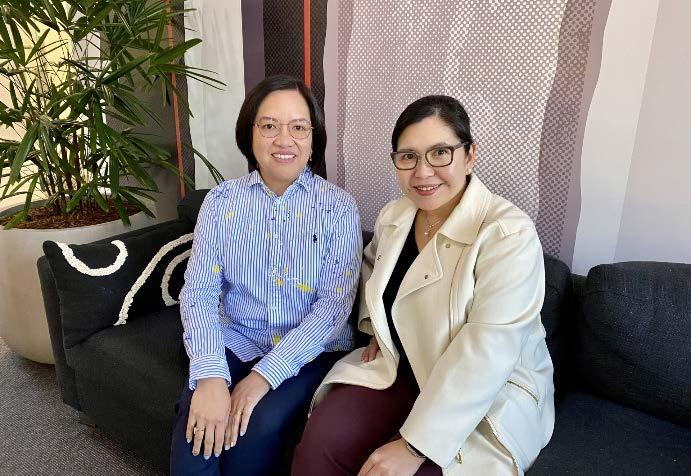
Dr Paresh Dawda, Director and Principal at Next Practice Deakin said Barb has been a fantastic asset to the team.
“Barb has demonstrated the enormous value of having a social worker embedded as part of the practice team, supporting our patients, family, carers and the practice team,” Dr Dawda said.
Kristy Stanford, practice manager at Wakefield Gardens Surgery also described the positive impact of having a social worker in general practice.
“Social workers help our patients to navigate the health care system, which can sometimes be complex. This eases the load on our GPs and enhances health outcomes for the patient,” Ms Stanford said.
CHN has funded 4 general practices to participate in the trial: Fisher Family Practice, Interchange Health Co-operative, Next Practice Deakin and Wakefield Gardens Surgery. The University of Canberra has
conducted an independent evaluation of the trial and its report will soon be available on the CHN website.
Patients of the participating practices can access a social worker through self-referral or referral from their GP or residential aged care facility. Carers and family members can also refer patients with their consent. The trial is supported by Federal funding. It has been extended until June 2025.
Capital Health Network (CHN) is ACT’s Primary Health Network (PHN). CHN is delivering 4 innovative trials to determine new models to improve health outcomes. These are:
The ACT Primary Care Pilot
The Family Safety Pilot
The ACT Breathlessness Intervention Service
The Social Workers in General Practice trial
PAGE 18 QUIZ ANSWERS: 1. Activated charcoal. 2. Christmas Disease – described by Dr Stephen Christmas. 3. They died on Christmas Day. 4. They were born on Christmas Day. 5. Melbourne. 6. Boxing Day. 7. In the 19th century, the rich boxed gifts the day after Christmas to distribute to their servants and others. 8. Cyclone Tracy, Darwin. 9. Love, Actually.
Across: 5. Arrhythmia, 8. Scleritis, 11. Vasculitis, 12. Tenesmus, 14. Atorvastatin, 16. Dysdiadochokinesia, 17. Sarcoidosis, 19. Fontanelle, 20. Obstipation, 23. Pheochromocytoma, 24. Rheumatoid, 25. Encephalopathy, 26. Cholecystectomy.
19. Fibroadenoma, 21. Amyloidosis, 22. Coarctation.
Down: 1. Sjogren's, 2. Nystagmus, 3. Osteomyelitis, 4. Paracentesis, 6. Proctalgia, 7. Kawasaki, 9. Phyllodes, 10. Vasectomy, 13. Melanoma, 15. Choledocolithiasis, 18. Tuberculosis,
PAGE 12 CROSSWORD ANSWERS:
JANE TWIN
MWS ACT committee member and past president
The Medical Women’s Society of the ACT and Region (MWS ACT) is a group of femaleidentifying medical doctors which aims to foster communication and support between medical women within the ACT and in the surrounding NSW towns. Our members live and work as far away as Crookwell and the Sapphire coast, spanning generations. The MWS ACT has developed a strong association with the ANU
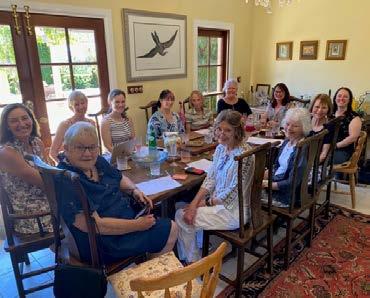
Medical School, with medical students on the committee, representing each year.
The MWS ACT has several roles: to develop collegiate networks, foster new relationships with those of similar interests and to support community events such as the Mother’s Day Fun Run.
We are composed of GPs, other medical specialists, doctors in training such as registrars and junior hospital doctors, as well as those working in private practice or in management and policy.
We meet several times a year at various venues, with different themes, but usually associated with dinner or cocktails. One of our gatherings is designated a fundraising dinner, where we specifically aim to raise money for charities related to women’s and children’s health, locally and globally. Others include a dinner to celebrate the achievements of students and doctors over the past year, an annual education event and a ski trip.
The MWS ACT takes a role in
student support and mentoring and participates in an annual event introducing various career paths and the juggle this represents for those women balancing work and family. Through our student committee members, we have been able to support individual students facing challenges with practical and moral support. More broadly, we sponsor the ANU Gender and Medicine Prize and two Student Elective Travel Bursaries each year.
Across Australia, local Medical Women’s Societies are affiliated with Australian Federation of Medical Women (AFMW) which is in turn affiliated with Medical Women International Association (MWIA). Through MWIA, we have an opportunity to liaise with organisations such as the World Health Organisation (WHO). In Australia, some of our members reside on national women’s lobby groups, aiming to influence policy, particularly regarding the health of women and children. Change starts locally with the view to expand, globally.
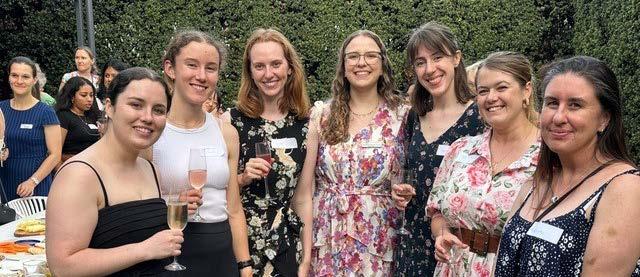
Student membership is free, while qualified medical practitioners are asked for an annual membership fee of $102.00, which finances AFMW affiliation. The membership fee for retired members is $82.00.
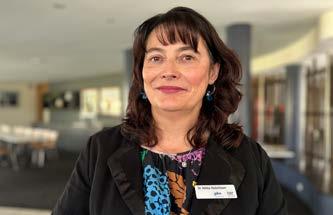
President of the MWS ACT, GP Dr Anita Hutchinson has first-hand experience of the immense value of the Medical Women’s Society of the ACT and region.
You've dedicated your career to the medical field; your hard work deserves to be rewarded.
Cutcher & Neale Accounting and Financial Services have supplied the following checklist to help you nurture your financial affairs.
Been thinking about purchasing an investment property?
Owning an investment property with debt structured correctly generally results in negative gearing; this means you benefit from the tax savings. Negative gearing
occurs when the expenses of owning an investment property exceed the income. This loss can be offset against your income.
Do you maximise your superannuation contributions annually?
Did you know you can contribute concessional superannuation contributions up to $30,000 annually?
This includes contributions made by your employer. Let’s say your taxable income is $200,000:
• Employer contributes $25,500
• Balance available to contribute from personal cashflow is $4,500
• Tax saving $2,115 in personal tax return; 15% tax paid in
superannuation fund
Earnings within super are also taxed at a maximum of 15%; the compounding effect of contributing more ‘sooner’ can have a profound impact at age 65.
Are you salary packaging to increase your take home pay?
Salary packaging can help you save money. You can package up to $9,010 of your salary tax-free.
When did you last review your interest rates and loan structure?
Lower rates with flexible loan structures will lead to faster debt reduction and increased
funds to consider other wealth accumulation strategies.
Are your study expenses tax deductible?
If you’re pursuing a master’s degree or further study (post undergraduate) related to your medical specialty, even if it’s funded via HELP Loans, those costs may be tax-deductible.
When did you last review your investment return within superannuation?
Focus on your industry superannuation account now; it’s important you understand
New members are always welcome.
To join, please use the QR code
“As a second-year medical student I found myself pregnant with two other children aged 3 and 5. I was part of the MWS committee and reached out to members for support. One of the committee members took me on as an obstetric patient and after delivery, members helped me negotiate with the medical school when it was time to return to study.”
your return to make sure you are maximising your future balance for retirement.
How will you meet your living expenses if you are unable to work?
Personal Risk Insurance is essential and needs to align to your debt; current and future living requirements. Life, Total & Permanent Disability and Income Protection Insurance safeguard your income in the event of death, illness or injury.

Dr Bill Coote, former secretary general of the AMA, recently scoured the records of the 1920 Australasian Medical Congress held in Brisbane. His discoveries reveal the long history of many challenges that continue in medicine a century on. They also show the dark creep of eugenics into medical forums in those interwar years.
This is the second part of Dr Coote’s feature on the 1920 Congress. The first part can be found in Issue 5 of Canberra Doctor, 2024.
BY DR BILL COOTE
After the 1920 Australasian Medical Congress, the MJA editorialised that “the medical profession in Queensland prepared an intellectual feast for their Australasian colleagues … Many new ideas or fresh application of established doctrines have proved anew that Congress has a high scientific value.”
There were eleven Sections: Medicine; Surgery; Obstetrics and Gynaecology; Pathology and Bacteriology; Public Health and State Medicine; Opthalmology; Otology, Rhinology and Laryngology; Neurology and Psychological Medicine; Disease of Children; Naval and Military Medicine and Surgery; and, Dermatology/ Radiology/and Medical Electricity. Each Section President gave an opening address to their Section. In his Presidential Address to the Section of Otology, Rhinology and Laryngology Dr Marks suggested the speciality had “become established on a firm scientific basis” and was “the great speciality which now occupies such an important position in and illuminates the medical landscape.”
By contrast, Dr Molesworth, Honorary Dermatologist at the Royal Prince Alfred Hospital, President of the Section of Dermatology, Radiology and Medical Electricity lamented that the “boundaries of dermatology are ill defined”. With “the introduction of new methods and new specialties” there existed “a good deal of overlapping” of dermatology with “the radiologist,
the venereal disease specialists and even with the surgeons… which leads to confusion and to some extent jealousy.” He referred to the “extraordinary frequency of rodent ulcer in Australia” and the need for dermatologists to manage “treatment by X-rays and radium.”
Dr Molesworth suggested: “the present seems to me a very suitable moment for the establishment of a suitable qualification for appointment to a skin department of the teaching and metropolitan hospitals…in the absence of a recognised course of study and attainment, appointments have to be made largely on guess-work and influence”. He proposed “…a definite effort should be made to define the scope of our specialities with only a reasonable degree of latitude…and to make special provision for post-graduate work.”
The Section of Surgery debated whether “a Fellowship of Australian Surgeons” should be created. The proponents suggested this would lead to “a higher grade of efficiency in surgical work, and provide for the bestowal of some hall-mark on the efficient.”
On this issue, the transactions record a tense debate. The President of the Section, Dr Newland was opposed, noting that “all the universities, with the exception of Sydney, provided a special and advanced surgical degree”. Dr Freshney from Toowoomba was concerned that “country practitioners would be cut off from the advantage of reading transactions of a closed corporation.”
Dr Andrew of Melbourne spoke strongly in favour of a national fellowship “…frank discussions and candid criticism were impossible in big meetings and it was only in a private gathering of specialists that men could rub off one another’s

angles and speak intimately of their difficulties and their failures”. Dr Craig accepted that “the public should have some means of differentiating the pure surgeon from the general practitioner”.
The President of the Section of Obstetrics and Gynaecology, Fourness Barrington, surveyed the state of the speciality. “Gynaecology, unlike obstetrics, is of recent birth; its development has been rapid and its achievements most brilliant. In the obstetrical art during well-nigh fifty years, marked results have been attained through our knowledge of infection. From the heavy death-rate following child-birth from sepsis, the technique carried out in hospital practice has almost eliminated the mortality”. He lamented that “the number of labours conducted in hospitals is a small fraction of the total births. Unfortunately… there is a terrible mortality… in spite of the advantages of improved sanitation, accurate scientific knowledge and improved instrumental appliances…The public should be taught that it is just as important to go to a hospital for childbirth as for a surgical operation.”
At each Section a wide range of papers were presented. About
120 papers were presented across the eleven sections.
As one example, the papers presented to the Diseases of Children Section were:
The “Presidential Address” on The Community and the Child;
Erythroderma or the “Pink Disease”; (first described by Dr Swift from Adelaide at the 1914 Congress in Auckland)
Special Types of Normal Children;
Strangulated Hernia in a premature baby, aged 4 weeks-Resection-Recovery;
The After-Treatment of Poliomyelitis;
Hydrocephalus-Operative Treatment;
Reduction of Intussusception by Hydrostatic Pressure;
Two Unusual Forms of Abnormal Tumours in Children, and;
The Gastro-Intestinal Troubles of Infancy.
Schoolchildren
Gertrude Halley MB ChB, Medical Inspector of Schools in South Australia was one of only three women to present a paper. The Public Health Section considered her “Survey of the children in the
far north of South Australia”. She examined 154 children at Maree and Oodnadatta schools: “the population is small and very scattered. At Maree school half the children attending are Afghans…There are no Aboriginal children in the schools, though a fairly large number live all along the line, and in camps around Oodnadatta”. Of children born in the north, 74% had vision below normal, compared to 11.7% in the south. Trachoma was the cause in most cases. “The flies are terrible…many of the homes are very poor – galvanised iron with mud floors and water is scarce,” she wrote. She also reported on the state of children’s teeth: “…in the north 73% of the children have good teeth as against 9% in the metropolitan region …I think accounted for partly by the fact sweets, shop pastry and such food is very little known in the north…” Halley concluded her paper with a jarring passing reference: “Last year (i.e.1919) a concert party went up North and spread influenza. Wherever they stopped, it very rapidly spread through the district, and many of the aborigines died.”
Commonwealth pathology laboratories
A surgeon from Grafton NSW, elected to Federal Parliament in 1919 as independent member for Cowper, presented a paper.
AMA would like to thank all our members for their vital support in 2024. By renewing your membership, you’re not just continuing your connection to the AMA, you’re ensuring your interests are represented and you will continue to help shape the future of healthcare delivery in the ACT and beyond.
At the Federal level, AMA has had several wins this year. Here’s a summary of some of those achievements.
AMA articulated a clear strategy to improve the nation’s health with the launch of its Vision for Australia’s Health in August. Minister for Health and Aged Care Mark Butler praised the document saying it contained “a helluva lot of good policy”.
In the area of public health, AMA had wins including world-leading restrictions on vapes, Government support for a sugar tax on soft drinks and reforms to the Health Star Rating system for food-labelling.
Continued from page 16
Earle Page (busy in 1920 creating the Country Party) presented a paper titled “Need for Country Laboratories” arguing “The country practitioner is, at the present time, very badly served in respect of clinical bacteriological work…… while his more fortunate brother in the city can get a culture made for him without any trouble”.
Page proposed establishment by the Commonwealth Government of laboratories in major provincial centres. Page saw these laboratories having important roles:
Typhoid control with examination of faeces and urine of convalescents and the faeces of contacts;
“Diphtheria control can most effectively be carried out by separating the carriers of the diphtheria bacillus from the normal individuals”;
“The examination of sputum for the tubercle bacillus would be one of the principal functions”.
The establishment of Commonwealth pathology
When it comes to general practice, AMA has been closely involved with Federal Government reviews of incentives, after-hours primary care and health workforce distribution. AMA continues to work constructively with the Federal Government and the Department of Health and Aged Care to ensure changes to these programs are evidence-based, reflect the realities of modern general practice, reduce redtape for GPs and improve patient care.
AMA continues to keep the spotlight on public hospital performance, with our annual Public Hospital Report Card. This year’s edition, released in April, showed planned surgery wait times were the longest on record, with emergency departments strangled by access block. AMA is advocating for reforms to reduce the logjam – our campaigning has already led to additional Commonwealth funding for public hospitals of more than $13 billion.
Following strong AMA advocacy, the Federal Government this year conducted a financial viability health check of private hospitals. Almost 2000 AMA members contributed to this work through our member survey.
laboratories commenced in 1921. By 1925 there were laboratories in Bendigo, Townsville, Toowoomba, Rockhampton, Lismore, Port Pirie, and Kalgoorlie.
Eugenics and focal infections with stasis
The Congress sought to inform practitioners of international developments. Two emerging areas on which papers were presented were later discredited.
JC Johnson, Professor of Biology in Auckland, in his paper “Heredity in Relation to Marriage” suggested “The time will soon come, if it has not come already, when a doctor must know something of eugenics and heredity…Advanced thinkers consider it is now imperative to see that the predominance of the white race is maintained. A fearless analysis of the weak points of the race, without false shame or sentiment is therefore necessary, with the discussion of how such deterioration may be eliminated or minimised…sooner or later legislation will be applied to the matter, just as it has been introduced in connection with sanitation and
Years of AMA advocacy on prostheses list reforms resulted in the win to retain general use items.
In 2024 AMA formed our International Medical Graduate Working Group (IMG-WG). The key objectives of the working group are to recommend actions the AMA can take to advocate for pathways to support work participation and career progression for IMGs, and to provide advice on how to ensure membership of the AMA is relevant to IMGs.
The AMA was quick to engage with governments when the IV fluid shortage first came to light. Our advocacy on IV fluid shortages led to the establishment of the National Response Group which meets each Monday with the AMA President in attendance.
In September Assistant Treasurer Stephen Jones announced a total ban on genetic discrimination in life insurance. This followed strong advocacy from AMA President Professor Steve Robson.
infectious diseases.” Johnson quotes approvingly an English doctor RR Rentoul’s book “Race Culture or Race Suicide”. Rentoul advocated compulsory sterilisation of “all idiots, imbeciles, feeble-minded, epileptics, lunatics, deaf-mutes, defective and backward children, habitual inebriates, habitual vagrants, public prostitutes, many sexual perverts, and markedly neurotic persons".
JHS Jackson, Physician to the General Hospital, Brisbane, spoke on Dental and Gingival Diseases from a Medical Standpoint. “The far-reaching effects of dental sepsis on systematic afflictions are now generally admitted. The most surprising of all, perhaps, is its connection with some psychoses. This has been previously noted and described, among others, by Dr Cotton of New Jersey. Many of us have been able to corroborate his findings”.
Henry Cotton (1876 –1933) was an American psychiatrist and medical director of the New Jersey State Hospital at Trenton. A 2005 Lancet review of a biography of Cotton (Madhouse: A Tragic Tale of
In the ACT, our president Dr Kerrie Aust has been active on radio, television and print media throughout 2024 highlighting the invaluable and irreplaceable work of doctors. Meanwhile, CEO Peter Somerville and senior workplace relations advisor Greg Schmidt have been persistent in fighting for a fair pay outcome through their work on the Medical Practitioners Enterprise Agreement. A better pay deal for salaried medical practitioners is expected in March, following a determination from the Fair Work Commission.
In the leadup to the ACT election in October, AMA ACT brought doctors and candidates together to hear from one another at our successful Politics in the Pub events. Our advocacy led to significant health promises, including Labor’s $4 million
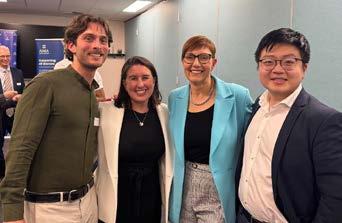
fund to support GP wellbeing and professional development. Our regular briefings with politicians and health system executives have led to sensible reforms, including most recently, the announcement that grandfathering arrangements will apply to the new Variations in Sex Characteristics (Restricted Medical Treatments) scheme.
AMA ACT has continued to provide support to enable the running of the vital Drs4Drs ACT service. Throughout the year, our office has also provided expert advice to members facing difficult workplace situations.
To renew your AMA membership or enquire about joining please visit ama.com.au/join
Megalomania and Modern Medicine) summarises his approach: “Cotton postulated a ‘bacteriological model of madness’ and accepted the aetiological theory of focal sepsis…effective treatment would require locating the sites of infection and removing them. Cotton began his experimental treatments by removing teeth from 50 patients, but after disappointing results he extended his treatments to tonsillectomies. Emboldened by the high rates of cure that he believed he saw, Cotton became such a true believer that in patients recalcitrant to cure he began to remove gall bladders, stomachs, uteruses, ovaries, testicles, even colons. By 1923, he was claiming cure rates as high as 85% among those who survived.”
The speaker’s comment that “Many of us have been able to corroborate his findings” raises an intriguing question: Were Cotton’s theories and methods adopted anywhere in Australia?
Conclusion
This article has offered some

observations on the first national meeting of Australasian medical practitioners after World War 1. Only a small sample of the issues debated by the Congress is discussed.
A News Magazine for all Doctors in the Canberra Region
ISSN 13118X25
All electoral matter in this edition of Canberra Doctor is authorised by Peter Somerville on behalf of the Australian Medical Association (ACT) Ltd.
Published by the Australian Medical Association ACT Ltd
Level 1, 39 Brisbane Ave, Barton ACT 2600 (PO Box 560, Curtin ACT 2605)
Editorial Sarah Colyer sarah-colyer@ama-act.com.au
Design Angela Wood reception@ama-act.com.au
Advertising Ph 6270 5410 Fax 6273 0455 reception@ama-act.com.au
Contributions
Canberra Doctor welcomes reader contributions. Submit your stories to editorial@ama-act.com.au
For more news
Visit ama.com.au/act
Follow us: bit.ly/amaactlinkedin /amaactbranch @AMA_ACT @amaact
Spread the word about your event, practice or organisation
Contact us to receive a copy of our Advertising Kit: reception@ama-act.com.au
Disclaimer
Canberra Doctor was delighted to receive a bundle of old photos recently from Dr Gerald Flynn of the AMA ACT fun-run teams from 1985 and 1986. Dr Flynn, an AMA fellow, worked as an anaesthetist in Canberra from the 1980s. He was a regular contributor to Canberra Doctor and was branch councillor of AMA ACT for a decade. The photos include former AMA ACT presidents Dr David McNicol (198788) and Dr Robert Allan (1992-93 and 2000-01).

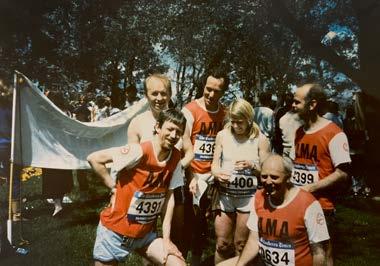

Have you got a favourite old photo of yourself with some friends in medicine? Why not send us a captioned copy and we’ll publish it in our next issue. Email editorial@ama-act.com.au
We’re introducing this new ‘Shout Out’ column, as a place to acknowledge colleagues who’ve gone above and beyond.
AMA ACT President Dr Kerrie Aust is kicking it off this month, with special thanks to a few shining stars. If you’re reading this and can think of other outstanding colleagues who deserve credit for something great they’ve done, please let us know at editorial@ama-act.com.au
Dr Kerrie Aust sends shout outs to:
Dr Meiri Robertson and the team at Canberra Fetal Assessment Centre for “going above and beyond for one of my patients”.
Deakin cardiologist Dr Kashif Kalam, “for always being available to talk through the management of patients”.
GP obstetrician and lactation consultant Dr Sarah Bombell, “because my patients have been raving about the excellent work you do to help young mums with breastfeeding”.
AMA ACT said goodbye to two much-loved staff members at the end of 2024; our membership and administration officer Karen Patten, and our corporate accountant, Tanya Smith. The AMA board and staff thank both Karen and Tanya for all their hard work, and wish them all the best for their next adventures.
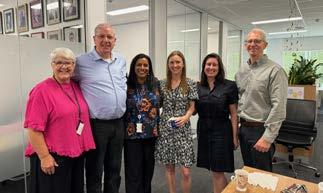

What is the standard opening treatment for mild mistletoe poisoning?

First described in the BMJ Christmas edition of 1952, what was the early name for ‘Haemophilia B” or factor IX deficiency?
What do Charlie Chaplin (1977), Pope Adrian I (795), and King Henry III (1406) all have in common?
What do Helena Rubinstein, Rebecca West, Quentin Crisp, Kenny Everett, and Dr Paul David, founder of the Montreal Cardiology Institute, all have in common?
Where in Australia would you be if attending the Boxing Day cricket test?
In Ireland, Italy, Poland, and many other countries, it is called St Stephen’s Day – what do we call it?
And why do we call it that?
What meteorological event occurred 21–26th December, 1974?
In what 2004 film was "the Christmas number one" a major plot point?
Find the answers on page 14












